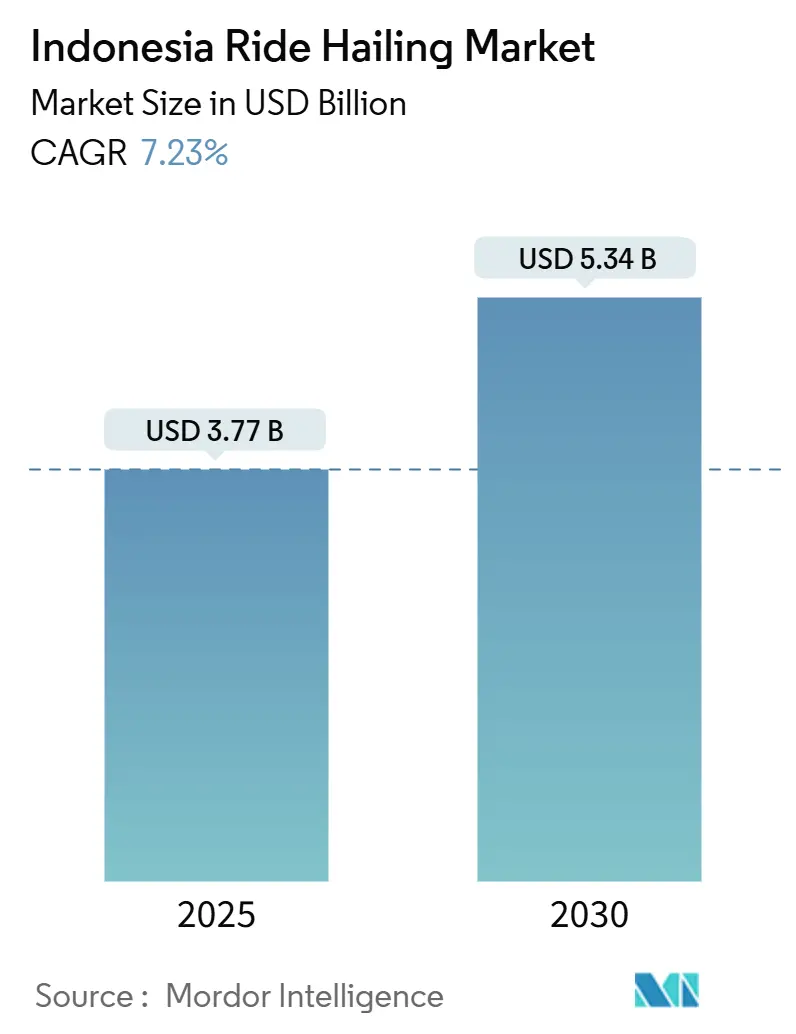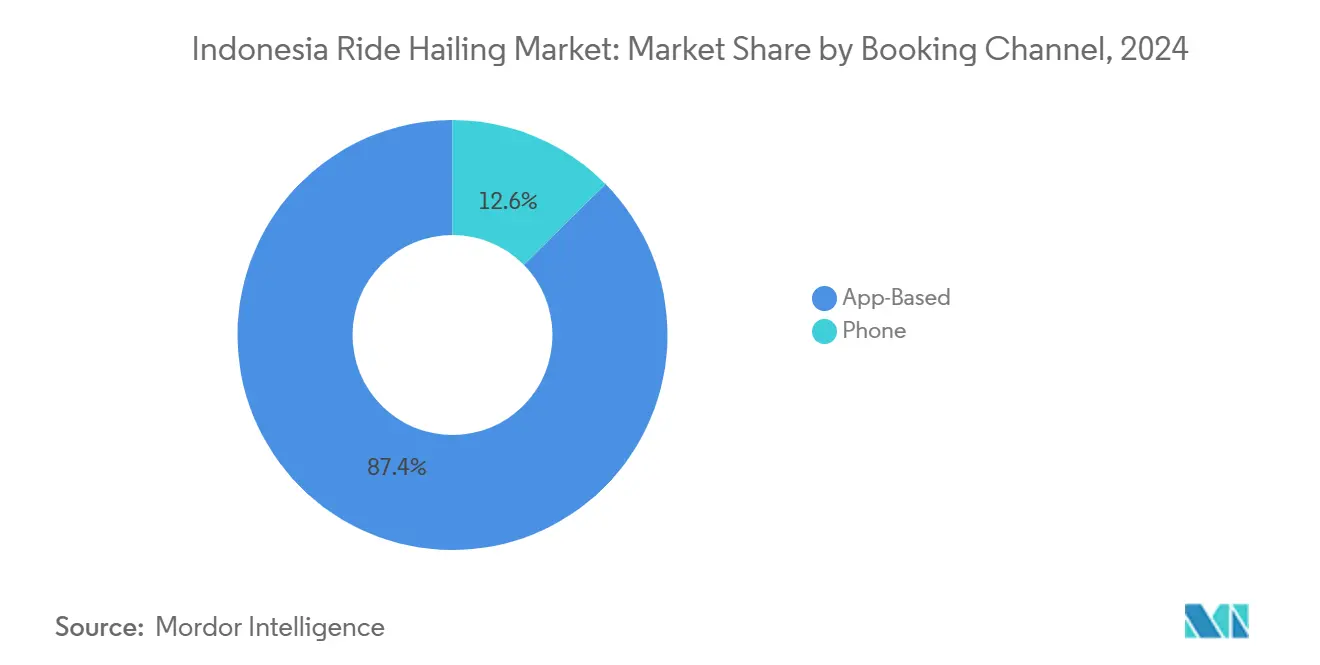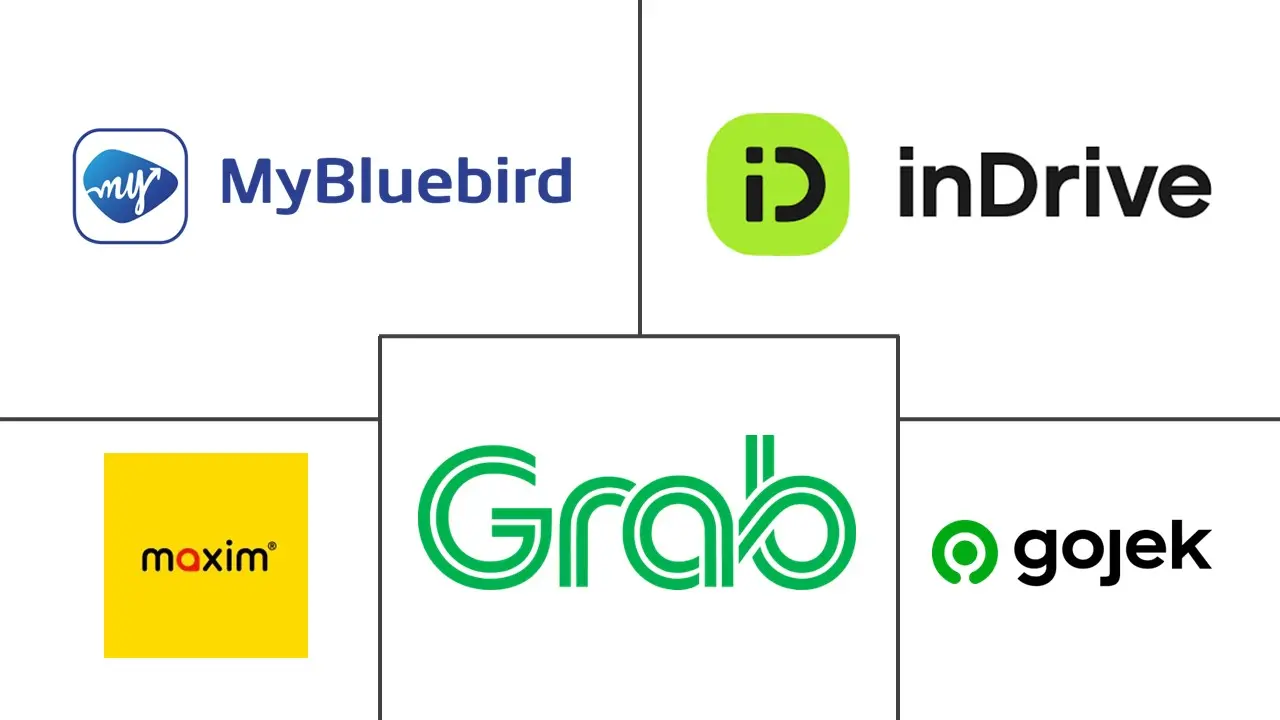
Indonesia Ride Hailing Market Analysis by Mordor Intelligence
The Indonesian ride-hailing market size is estimated at USD 3.77 billion in 2025, and is expected to reach USD 5.34 billion by 2030, at a CAGR of 7.23% during the forecast period (2025-2030). This growth trajectory is underpinned by resilient post-pandemic demand, GoTo and Grab’s pivot toward sustainable unit economics, and accelerating electrification initiatives that lower operating costs and emissions. Two-wheeler services reinforce the market’s mass-appeal value proposition in congested cities, while battery-swap networks mitigate range anxiety for electric fleets. Autonomous vehicle pilots, first-/last-mile integrations with rail and bus systems, and bundled corporate subscription plans expand use cases for the Indonesian ride-hailing market, positioning platforms to capture incremental trips as urbanization intensifies. Regulatory headwinds, including commission caps, potential fuel-subsidy removals, and antitrust scrutiny, temper margins but have not derailed the sector’s steady migration toward profitability.
Key Report Takeaways
- By vehicle type, two-wheelers captured 63.48% of the Indonesian ride-hailing market share in 2024 and are projected to advance at a 7.27% CAGR during the forecast period (2025-2030).
- By propulsion, internal combustion engines held 99.43% of the Indonesian ride-hailing market size in 2024, while battery-electric vehicles are forecast to post the highest 7.25% CAGR during the forecast period (2025-2030).
- By service type, e-hailing commanded 86.37% of the Indonesian ride-hailing market share in 2024, and robo-taxis are expected to record the fastest 7.28% CAGR during the forecast period (2025-2030).
- By booking channel, app-based reservations accounted for 87.38% of the Indonesian ride-hailing market size in 2024 and are expected to grow at a 7.31% CAGR during the forecast period (2025-2030).
- By end-user, personal riders account for 77.32% of the Indonesian ride-hailing market share in 2024, while corporate and institutional customers are forecast to expand at a 7.33% CAGR during the forecast period (2025-2030).
Indonesia Ride Hailing Market Trends and Insights
Drivers Impact Analysis
| Driver | (~) % Impact on CAGR Forecast | Geographic Relevance | Impact Timeline |
|---|---|---|---|
| Rapid Urbanisation | +1.8% | Java-centric, Jakarta metropolitan area | Medium term (2-4 years) |
| Government EV Incentives | +1.5% | National, early adoption in Jakarta, Surabaya | Long term (≥ 4 years) |
| High Smartphone / E-Wallet Penetration | +1.2% | National, urban concentration | Short term (≤ 2 years) |
| Public-Transport Integration Boosts First | +0.9% | Jakarta, Bandung, Surabaya | Medium term (2-4 years) |
| Dense Battery-Swap Station Roll-Out Along Ojek Corridors | +0.8% | Jabodetabek, expanding to major cities | Long term (≥ 4 years) |
| Subscription Bundles For SME Employee | +0.6% | Urban centers, industrial zones | Medium term (2-4 years) |
| Source: Mordor Intelligence | |||
Rapid Urbanization & Chronic Traffic Congestion
In 2024, Jakarta drivers spent hours stuck in traffic, marking a significant increase in congestion compared to 2023. This delay ranked Jakarta as the tenth most congested city worldwide. Such traffic woes keep on-demand mobility at the forefront of commuters' minds, increasingly seeking time savings through optimized routing. With Indonesia boasting a high urbanization rate, demand is heavily concentrated in Java, the epicenter of the country's ride-hailing market. In July 2024, new toll roads, including the Cimanggis-Cibitung corridor, opened up previously underserved suburbs. However, these routes still direct riders back into the city's congested core. While fuel prices are set to rise due to subsidy reforms announced in September 2025, shared two-wheeler rides continue to be a cost-effective choice for daily commuters, solidifying their habitual use.
Government EV Incentives For Two-Wheel Ride-Hailing Fleets
Indonesia's roadmap to achieving net-zero emissions by 2060 includes tax incentives and subsidies for fleets transitioning to electric motorcycles. In the first half of 2025, electric vehicles (EVs) made up a significant portion of active two-wheelers in ride-hailing, a figure that has doubled, in part due to Grab's fleet of electric vehicles, which has successfully reduced CO₂ emissions. With battery-swap stations established nationwide, mostly in Java, charging downtimes are minimized, leading to increased vehicle utilization. Additionally, regulations set by the Ministry of Transportation ensure standardized safety measures and conversion protocols.
High Smartphone / E-Wallet Penetration
With multiple internet users and mobile connections, Indonesia’s app-centric population provides the digital rails for the Indonesian ride-hailing market. QRIS standards and e-wallet ubiquity enable cashless transactions that shorten booking flows and support dynamic pricing [1]“QRIS Adoption Statistics 2025,” Bank Indonesia, bi.go.id . GoPay surpassed 20 million downloads by March 2024, illustrating the cross-sell potential between fintech and mobility. Government API standardization through Telkomsel’s CAMARA-compliant framework further lowers integration costs for third-party developers, enhancing feature velocity on ride-hailing super-apps.
Public-Transport Integration Boosts First / Last-Mile Demand
In its inaugural month, Gojek's GoTransit partnership with KRL commuter rail saw a remarkable trip surge. Many GoRide journeys in Jakarta commence or conclude at a train or bus station. The JakLingko integrated fare card and an MRT ridership boasting millions of monthly users channel untapped demand into multi-modal journeys. Data-sharing agreements, formalized through provincial MOUs in June 2025, empower ride-hailing platforms with enhanced insights into peak-hour flows, enabling them to allocate incentives strategically.
Restraints Impact Analysis
| Restraint | (~) % Impact on CAGR Forecast | Geographic Relevance | Impact Timeline |
|---|---|---|---|
| Price-War Duopoly and Looming Grab–Goto Consolidation Scrutiny | -1.1% | National, regulatory focus on Jakarta | Short term (≤ 2 years) |
| Driver Protests and Regulator-Capped Commissions Squeeze Margins | -0.8% | Urban centers, strongest in Jakarta | Medium term (2-4 years) |
| Swappable-Battery Quality Issues | -0.6% | Java-centric, battery-swap station locations | Medium term (2-4 years) |
| Patchy 4G/5G Coverage Outside Java | -0.4% | Outer islands, rural areas beyond Java | Long term (≥ 4 years) |
| Source: Mordor Intelligence | |||
Swappable-Battery Quality Issues Cause Service Downtime
Battery swap networks are grappling with higher failure rates than traditional plug-in chargers. This discrepancy results in unexpected downtimes, adversely affecting drivers' earnings and the overall reliability of the platform. A pilot project by Oyika in Jakarta underscores the vulnerability of these systems; a single station's failure during peak hours can send ripples through the entire network, disrupting services for riders.
These outages resonate even more in Java, where most swap sites are located. The involvement of proprietary batteries from suppliers such as SWAP Energy, Volta Indonesia, and Electrum adds another layer of complexity to quality control. As the Ministry of Transportation works on drafting safety regulations, operators are left in a lurch, uncertain about the potential retroactive compliance costs. This ambiguity poses a risk of temporary halts in network operations as they scramble to make necessary upgrades.
Patchy 4G/5G Coverage Outside Java Limits App Bookings
For ride-hailing services, consistent connectivity is paramount for GPS navigation, pricing accuracy, and seamless cashless transactions. However, network quality takes a hit outside the bustling region of Java. The outer islands grapple with sporadic 4G connectivity and a scarcity of 5G, leading to user frustrations and a dip in driver acceptance rates. While Telkomsel concentrates its efforts on urban areas within Java, rural regions are left waiting. As a result, ride-hailing platforms are strategically focusing on areas with reliable connectivity, inadvertently stunting growth in provinces that remain underserved. Although the government is making strides to address the digital divide, progress has been sluggish. This delay means that expansions into the outer islands hinge on the outcomes of future spectrum auctions and the construction of new towers.
Segment Analysis
By Vehicle Type: Two-Wheelers Anchor Mass Mobility
Two-wheelers captured 63.48% of Indonesia's ride-hailing market share in 2024 as nimble motorcycles navigate Jakarta’s average speeds more effectively than cars. The segment is projected to grow at a 7.27% CAGR, outpacing the broader Indonesia ride-hailing market through 2030. Internal combustion engine (ICE) bikes lead the market in volume. Yet, electric scooters are carving out a significant niche in the active ride-hailing arena. These scooters outpace traditional four-wheelers, completing notably more trips on average. Adoption lags in rural areas, but suburban regions are witnessing robust growth, fueled by enhanced connectivity from new toll-road infrastructure. This growth spurt opens doors for two-wheeler operators to tap into rising demand.
Vans, MPVs, and minibuses serve demand for niche group travel and airport shuttles. Passenger cars cater to comfort-seeking users on longer intra-city routes, but traffic and parking constraints keep growth muted. Three-wheelers and buses remain peripheral to the Indonesian ride-hailing market, constrained by regulatory licensing and low consumer familiarity.

Note: Segment shares of all individual segments available upon report purchase
By Propulsion Type: Electric Momentum Builds
Internal-combustion engines retained 99.43% of the Indonesian ride-hailing market size in 2024 but face gradual displacement. Battery-electric rides are forecast to post a 7.25% CAGR to 2030, reinforced by tax waivers and falling battery costs. Under Indonesia's Permenhub No. 39/2023, government-approved ICE-to-EV conversion kits have slashed the upfront costs for drivers, paving the way for broader electrification. At the same time, battery-swap-ready scooters from companies like Electrum and NIU are cutting down downtime by avoiding lengthy charging sessions.
While hybrid two-wheelers boast technological promise, their higher purchase price is likely to keep them as a niche solution, overshadowing the operational savings they provide. On the other hand, CNG and LPG alternatives are only gaining traction in certain areas, primarily limited by the presence of localized refueling infrastructure.
By Service Type: E-Hailing Dominance, Robo-Taxi Emergence
E-hailing held 86.37% of the Indonesian ride-hailing market share in 2024, thanks to established brand familiarity and wide driver networks. Autonomous pilots such as Grab’s low-speed shuttle trials push robo-taxis toward a 7.28% CAGR, though volumes remain embryonic.
Peer-to-peer car-sharing suffers from insurance hurdles, while monthly ride packages find traction among enterprise clients seeking budget certainty. AI-driven matching engines and fraud detection boost service reliability, keeping incumbent platforms sticky even as entrants tout novel propositions.
By Booking Channel: Apps Solidify Pre-Eminence
App channels processed 87.38% of the Indonesian ride-hailing market size in 2024 and are projected to grow at a 7.31% CAGR. Features like predictive ETA, multi-modal trip planning, and embedded BNPL options significantly boost user engagement by offering convenience and flexibility. While phone bookings remain common among digitally excluded groups, their prevalence wanes with the rise of affordable smartphones in rural regions, enabling broader digital adoption. With the adoption of CAMARA-standard APIs bolstering security, financial institutions are increasingly integrating mobility services into their super-apps. This integration not only enhances user experience but also amplifies the dominance of app-based services in the mobility market.

By End-User: Corporate Segment Accelerates
Personal riders formed 77.32% of trips in 2024, but corporate/institutional demand is expanding fastest at 7.33% CAGR. Companies replace fleet leases with on-demand mobility to reduce parking costs and simplify expense reconciliation. GoCorp and emerging white-label ride solutions integrate HR systems, offering policy-based booking controls and centralized invoicing.
Sector-specific use cases—from patient transfers in healthcare to test-drive pickups in automotive—multiply addressable B2B volumes. The Indonesian ride-hailing industry benefits from this diversification as corporate customers exhibit higher ride frequency and stickier contracts.
Geography Analysis
Java accounts for most rides, infrastructure, and revenue, reflecting three-fifths of swap-station deployments and the densest smartphone penetration. Jakarta alone generated the largest share of the Indonesian ride-hailing market size in 2024, propelled by congestion hours annually that incentivize shared trips. MRT and TransJakarta hubs act as multipliers, with 1-in-5 GoRide journeys now linked to rail or bus nodes [2]“MRT Ridership Report Nov 2024,” Jakarta Provincial Government, jakarta.go.id .
Secondary hubs such as Surabaya and Bandung record double-digit trip growth on the back of new arterial roads and widening 4G/5G coverage. Battery-swap networks have started branching into these cities, shortening adoption lags compared with Jakarta’s early EV roll-out.
Outer-island provinces remain relatively underpenetrated due to sparse populations and limited digital infrastructure, yet targeted scholarship programs have seeded driver supply in multiple smaller cities. Government road projects that cut travel times—like the Cimanggis-Cibitung link—extend platform viability into suburban districts, rebalancing geographic revenue concentration over time.
Competitive Landscape
In Indonesia's ride-hailing arena, companies such as GoTo and Grab reign supreme, and their combined heft creates network effects that ward off potential challengers. In 2024, both companies pivoted from offering volume subsidies to honing in on take-rate optimization. By Q3 2024, GoTo boasted an adjusted EBITDA while witnessing an uptick in on-demand GTV. Meanwhile, Grab is weaving a multi-vertical tapestry, intertwining mobility, food delivery, and payment services to amplify user lifetime value.
Technology is now the primary battleground. GoTo’s Bahasa-native Sahabat-AI engine personalizes promotions, whereas Grab deploys machine-learning models to predict demand spikes and pre-position drivers, compressing waiting times. InDrive differentiates with rider-driver fare negotiation and a commission ceiling below 10%, attracting cost-sensitive drivers [3]“Indonesia Expansion Update 2025,” inDrive, indrive.com . Xanh SM’s December 2024 EV taxi launch introduces a sustainability-led narrative that appeals to corporates with ESG targets.
Regulators enforce one-fifth commission caps plus mandatory welfare contributions, preserving room for challenger models yet limiting pricing wars. Antitrust oversight of potential consolidation keeps strategic options fluid; any merger would trigger stringent remedies, ensuring the Indonesian ride-hailing market remains contestable even as incumbents edge toward profitability.
Indonesia Ride Hailing Industry Leaders
-
PT Aplikasi Karya Anak Bangsa (Gojek)
-
Grab Holdings Inc.
-
Maxim Rides Indonesia
-
inDrive
-
Blue Bird Group (MyBluebird)
- *Disclaimer: Major Players sorted in no particular order

Recent Industry Developments
- September 2025: Dat Bike secured USD 22 million in a Series B funding round, aiming to expand its electric motorbike production capacity, enhance its manufacturing capabilities, strengthen its research and development efforts, and establish strategic partnerships within the ride-hailing industry.
- December 2024: In Jakarta, Xanh SM launched its all-electric VinFast Limogreen taxis, marking a significant step in the adoption of electric vehicles (EVs) in the region. The company has set an ambitious goal of deploying 10,000 EVs by 2025, aiming to contribute to sustainable urban mobility and reduce carbon emissions.
Indonesia Ride Hailing Market Report Scope
Ride-hailing allows for booking rides and paying for service through an app with a transportation network company (TNC), where the market comprises vehicle types, such as motorcycles and cars.
The Indonesian ride-hailing market is segmented by vehicle type, booking type, and end use. By vehicle type, the market is segmented into two-wheelers and passenger cars. By booking type, the market is segmented into online and offline. By end use, the market is segmented into personal and business. For each segment, the market size and forecasts are done based on value (USD).
| Two-Wheelers |
| Three-Wheelers |
| Passenger Cars |
| Vans & MPVs |
| Buses & Shuttles |
| Internal-Combustion (ICE) |
| Hybrid |
| Battery-Electric |
| CNG / LPG |
| E-Hailing |
| Car-Sharing (Peer-to-Peer) |
| Robo-Taxi |
| Subscription-Based Ride Packages |
| App-Based |
| Phone |
| Personal |
| Corporate / Institutional |
| By Vehicle Type | Two-Wheelers |
| Three-Wheelers | |
| Passenger Cars | |
| Vans & MPVs | |
| Buses & Shuttles | |
| By Propulsion Type | Internal-Combustion (ICE) |
| Hybrid | |
| Battery-Electric | |
| CNG / LPG | |
| By Service Type | E-Hailing |
| Car-Sharing (Peer-to-Peer) | |
| Robo-Taxi | |
| Subscription-Based Ride Packages | |
| By Booking Channel | App-Based |
| Phone | |
| By End-User | Personal |
| Corporate / Institutional |
Key Questions Answered in the Report
How large is the Indonesian ride-hailing market in 2025?
The Indonesian ride-hailing market size is USD 3.77 billion in 2025, with a 7.23% CAGR outlook to 2030.
Which vehicle type dominates ride-hailing in Indonesia?
Two-wheelers lead with 63.48% share in 2024, favored for maneuverability in congested streets.
What is driving electric vehicle adoption in Indonesian ride-hailing?
Government tax waivers, battery-swap roll-outs, and operator cost savings propel a 7.25% CAGR for electric rides.
How are corporate users shaping demand?
Corporate and institutional clients purchasing subscription bundles are the fastest-growing segment at 7.33% CAGR through 2030.
Which booking channel is preferred by Indonesian riders?
App-based bookings command 87.38% of transactions, thanks to cashless payments and real-time tracking.
Are autonomous taxis a realistic near-term prospect in Indonesia?
Robo-taxis are in pilot phase but are forecast to post a 7.28% CAGR, supported by growing consumer familiarity and evolving regulations.
Page last updated on:



